

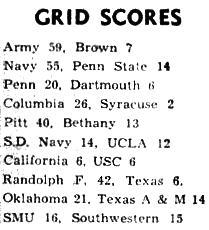
VOL. III NO. 5 REG NO. L5015 DELHI, THURSDAY OCTOBER 12, 1944
|
Gen. Joseph W. Stilwell revealed this week that very few of the original men of Merrill's Marauders took part in the actual capture of Myitkyina and that two of three battalions, composed largely of green replacements, carried a great weight of the assault against veteran Japanese troops.
The First Battalion was composed of Merrill's original men, but the Second and Third battalions were made up of replacements, some of whom had been flown in and saw action within a week of their arrival in CBI.
Said Stilwell, "These troops were naturally green. In some cases, they were raw. Yet, they fought courageously and with steady improvement until the entire force of Chinese and American Engineers, pulled off the Ledo Road, and the new and old Marauders, captured the town."
Yank Gets His Desire
HQS., 10TH AIR FORCE, INDIA - In a sergeant's desire to carry death to the enemy lies a saga of American fighting that rests deep in the nation's traditions.
S/Sgt. Phillip R. Skaags, of Ansted, W. Va., now listed as missing in action, had for four long years ably performed clerical duties in the Seventh Bombardment Group, 10th Air Force, Eastern Air Command. He had entered the Army Air Force in January, 1940, rising to the grade of staff sergeant by December, 1942.
Soon after, he began to plead with his commanding officer to be allowed to take training as an aerial gunner. Because of the good work he had been doing in the clerking job, the commanding officer did not consider a transfer to gunnery in the best interest of the service.
However, Skaggs kept up his pleading until finally he was given a mental exam on gunnery which he passed with colors flying. Then he skillfully manned a gun on a trial mission. This decided his CO. He agreed to the gunnery training and soon after Skaggs was in combat. he had many hours to his credit, had won the Air Medal and even had the coveted opportunity to return home if he desired.
But he kept on his combat job until one day recently his ship failed to return and after his name in the group records were entered the words, "missing in action." Direct dealing of death to the enemy had been the sergeant's desire and he had carried out this wish to the fullest extent.
ETO FIGHTER VETERANS FLY OVER CBI
HQ., TENTH AIR FORCE, INDIA - One of the most travelled fighter groups in the Army Air Force is now fighting with the 10th Air Force, Eastern Air Command. This P-47 Thunderbolt outfit boasts a total of 26 major moves since storming North Africa from aircraft carriers during the invasion in November, 1942.
Not only have the camp sites moved rapidly, but the group's fighters have swiftly swept the skies, on one occasion in Tunisia, knocking out 42 German planes in 12 days of operation. This group also took part in the
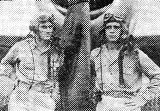 German planes have fallen under the guns of these two pilots, Capts. Charles C. Hammon and William I. Usher,
now seeking victories against the Japs in Burma. They fly with the Flying Crow squadron.
German planes have fallen under the guns of these two pilots, Capts. Charles C. Hammon and William I. Usher,
now seeking victories against the Japs in Burma. They fly with the Flying Crow squadron.
|
Pup tents near the flight strip served for homes when the group finally settled down in North Africa. The African battle quickly moved into Tunisia and the group followed closely, being the first fighter organization to operate from Tunisian soil.
Soon after came the move to the Pantelleria hangar, then to tents in Sicily and finally pup tents again on the Salerno beachhead. In the latter operation the ground echelon was mustered into service as an infantry reserve.
From the tents of Italy to the bashas of India was the next experience of the traveling fighter boys.
Among the travel notes of this group are: the rejuvenated Lafayette Escadrille flew with them in Tunisia; the 99th Squadron, all Negroes, took part in the group's operations in Sicily, and Col. Philip G. Cochran, then a major, was commanding officer of the outfit for a period of several months.
|
The Flying Crow squadron of this group at one time had enlisted men with an average of five years service each and only three men in the first three grades who came into the outfit through the Selective Service system. Two line chiefs of the Flying Crow squadron and the Red Gorillas squadron have a combined service of 45 years in the Air Force.
The group has more than 130 German planes credited as victories.
MME. CHIANG BETTER
NEW YORK - (ANS) - Madame Chiang Kai-shek faces a long period of convalescence but is assured of ultimate recovery from the illness which brought her to the U.S., her physicians said this week. The first lady of China is now at Columbia Presbyterian Medical Center.
MEET CENSORS' BIG BURDEN AT 885
This G.I. claims he's the greatest burden to the censors in CBI.
Pfc. Ward Cramer of APO 885, just to start a controversy, claims to be the letter-writingest man in China, Burma, and India.
Since Jan. 1, Cramer has burdened local censors with no less than 860 personal reports bound for Shangri-La. He admits most of these have gone to the missus back in Columbus, O. He is equally no less hesitant to admit he hasn't received an answer from each of them.
Bronze Stars For Producing
ASC BASE, INDIA - For developing a molding sand by adding molasses, for quick construction of hangars and warehouses, rapid completion of runways and roads, reclamation of crashed aircraft, and for increased productivity of an overhaul plant and machine shop, three enlisted men and two officers of the CBI Air Service Command at this base have been awarded the Bronze Star.
S/Sgt. Edward R. Dillen, of Cleveland, received the award for devising a foundry to produce vitally needed parts for putting damaged aircraft in the air again. With sand from a nearby river and a mixture of molasses, he developed a molding sand, which proved more satisfactory than any obtainable in CBI. His foundry has turned out more than 500 types of castings.
CONSTRUCTION EXPERT
The award was made to M/Sgt. William M. Johnston, of Johnstown, Pa., for constructing buildings at a base which consisted of little more than arid, dusty land when he went to work. With unskilled Indian labor and forced to fabricate substitute building materials, Johnston was able to erect 18 buildings in the comparatively short period of six months.
Credit for rapid completion of runways and roads was ascribed to T/Sgt. John L. Pope, of Houston, Tex. Road-building and runway equipment was in disrepair and vital parts were lacking to recondition bulldozers, power cranes and road graders. He was awarded a Bronze Star medal for improvisation in getting this equipment back in operation.
PLANE SAVING
Maj. Durward L. Crow, graduate of the University of Alabama and West Point, was cited for his efforts in reclamation of crashed aircraft at a critical time when each ship counted heavily in the projected plans of the Air Force.
Efficiency and productivity of the overhaul plant and machine shop at the base was praised in the citation of Maj. Jessie F. Jenkins, of San Antonio, Tex. Without standard, usually necessary, machinery, the graduate of the University of Texas was able to accomplish repair and maintenance of aircraft by varied means of improvisation.
DEATH NO RARITY AMONG COOLIES
By JACK GUINN United Press Correspondent
CALCUTTA - Death is no rare occurrence in the Far Eastern theater of war, and we have all seen a lot of it, but I think the most startling and most impressive death I've seen was a rickshaw coolie who had dropped in wide-eyed staring death apparently while trotting along with his little two-wheeled carriage.
Harrison Salisbury, United Press Foreign Editor, John Andrew, UP War Correspondent, and I were riding in rickshaws down through the narrow, winding, smelly alleys of Calcutta's Chinatown, trying to get out of the maze of shrill noise and filth after spending a couple of hours in a fabulous restaurant where shrimp was cooked in syrup.
The coolie lay on his back, his features drawn from the strain of a comparatively few years of trotting mile after mile in Calcutta's sweltering heat, dragging his rickshaw behind him. Always trotting. His eyes were wide open, and set in that peculiar way you find in some paintings, so that no matter how you looked at him he seemed to be looking at you. He was stripped to the waist, but that's the way they dress.
|
He was the deadest man I've seen in the war. To me, even the decaying Japanese are not half so dead. They're no more dead than a ruined piece of machinery, a demolished automobile, a rifle barrel that's exploded because it was full of mud.
Because this man had not been killed by war. He had not been killed by death. He was killed by life.
They say out here that for a coolie to drop dead in his traces is not a rare thing. They do it all the time. And they're all young, both in years and in their profession. It doesn't take much running in the hot sun to kill a man.
Of Calcutta's more than 2,000,000 population, more than 35,000 persons are rickshaw coolies.
Nobody knows offhand how many coolies drop dead per year.
Nobody worries about it much.
Not even the coolies.
Chinese Salute Accuracy Of 14th Bombers
HQ., 14TH AIR FORCE - There are times when a miss is a hit.
Chinese and Japanese forces were battling for the possession of a city in Hunan Province in China. The Japs held the edge of the town.
The Chinese requested the 14th Air Force to bomb the enemy-held area, but before the arrival of the U.S. bombers, the Chinese drove the Japs from the edge of the city into the rice paddies on the outskirts.
Unaware of this last-minute development, the bombers arrived and aimed their bombs at the edge of the town as requested. But the bombs missed their target slightly and landed in the rice paddies among the concealed Japs.
The Chinese were speechless with admiration and astonishment at this display of American omniscience and accuracy.
YOU WANNA BUY HOT ROCK, JOE?
A couple of G.I.'s from a heavy bomber base are wondering if the old copybook maxim, "honesty is the best policy," has been translated into Hindustani.
The boys ran into a jewel-wallah who displayed the usual assortment of star sapphires and Burma rubies at the usual interesting prices. Then, seeing skepticism on their countenances, he pocketed the gems and pulled out a beautiful white sparkler.
"You like?" he asked eagerly, then lowered his voice and confided, "thees ee-stone, sahibs, ees januwine ee-glass!"
What the dumbfounded boys would like to know is, was it honesty? Or had some CBI slicker given the innocent jewel-wallah a story? Your guess is as good as theirs. What do you think? - Pfc. R. W. Oberg.
(The only topper we can think of for this story is the silver, ivory and brass merchant who braced a party of G.I.'s with the plea, "Would you Joes like to look at some of this junk?" - Ed.)
'SOMEWHERE IN HELL'
By Cpl. C. M. BUCHANAN Roundup Staff Correspondent
(The following narrative account of the rescue of an Air Force fighter pilot from the Burma jungles is reported not only as an excellent job of reporting but is unusually newsworthy in that it is one of the few occasions when an operation of this sort has been so thoroughly covered by the camera. Our respects to the correspondent who filed the story, Cpl. C. M. Buchanan, and to Sgt. Charles L. Zimmerman, photographer, who covered for the Signal Corps. - Editor).
One day last month, a Naga runner brought a note to an Army Intelligence Office in Burma. The Captain took it. His face tightened. "SOMEWHERE IN HELL" the heading said. He read aloud, "I am the pilot who crashed . . . I need a pair of G.I. shoes, quinine, socks, cloth, sulfa for boils and infections rotting my limbs off. I'd like to borrow a blanket, if you can spare one. Cold. Cigarettes would be nice. I'm ashamed of asking for so much. Thanks for whatever you can do . . Lt. G. M. Collins."
There was a postscript expressing the belief that the writer could find his own way out, but the uncertain handwriting and the halting text spoke eloquently of weakness and delirium.
Lt. Greenlaw M. Collins was skimming across Northern Burma on July 29th last when his P-51 fighter went into a spin. There wasn't much time - and no choice. Collins opened the hatch and bailed out. The jungle where the flyer landed is a death trap. Mountains 8,000 to 10,000 feet high, piled in a reckless heap by Nature's hand,
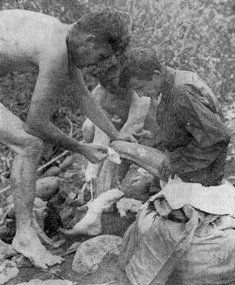 Maj. William H. Spruell, who parachuted into Geda Ga to the aid of Collins, treats wounds suffered from
blood-sucking leeches.
Maj. William H. Spruell, who parachuted into Geda Ga to the aid of Collins, treats wounds suffered from
blood-sucking leeches.
|
In past generations a race of head hunters, the little, hardy tribesmen today live peaceably on hill peaks, better to protect themselves against the fury of the monsoon and the less friendly jungle denizens.
Luck was out for Collins that day. His tropical kit, sole protection against the wilds, was lost. Stunned, the lieutenant made his way through the steaming, stinking mass of rotted leaves, entangled vines and thorny growth. He rested and took stock of his situation. He had no knife, no weapon, no safeguards against the bite of the malaria mosquitoes. Leeches, ready to suck his life's blood, plodded their slimy way toward him. Drenching rain chilled his shivering bones. He was a solitary soul in a sea of endless vegetation and crawling pests. That was on July 29th.
The day Collins jumped, a C-47 pilot reported seeing a parachute floating to earth many miles east of the Ledo Road. Aided by Army men, native patriots were immediately organized and dispatched to the mountain trails where the parachutist was reported. A group of Gurkha soldiers was unable to find a trace of Collins.
Several Naga missions combed the area, but the mountain trails and thicket made the going slow and uncertain. Planes trolled the jungles in slow sweeps, looking for a wisp of smoke, the silk of the parachute, the flash of a signal mirror. They couldn't know that the jungle kit had been lost. The days wore on and there were no signs of life.
For protection against malaria mosquitoes, ants and other crawling pests, the pilot removed his undershirt, wrapped it around his face and replaced the leather helmet. He made gloves of his socks to cover the exposed flesh of his hands. He tucked his pants into ankle high boots. At night he would button his khaki shirt to the neck and curl up in a semi-circle on the damp, cold ground.
After almost a month Collins was found by a Naga searching party. He was too weak and sick to move. For four days he ate. Then the Nagas helped him to the nearest settlement on a mountainside. This took two days.
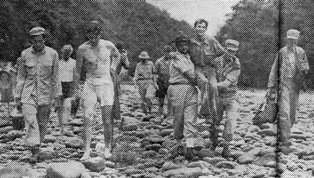 Maj. Michael K. O'Heeron (left) and Lt. Glenn Bateman (right) carry Collins from the raft to the assault boat
for the trip down the Tarung River.
Maj. Michael K. O'Heeron (left) and Lt. Glenn Bateman (right) carry Collins from the raft to the assault boat
for the trip down the Tarung River.
|
When discovered by the Nagas, the flyer's clothes were tattered, his boots rotted off. He was bearded, fever-ridden and starved. Collins had tried to conserve his energy by following streams that furnished water. He built crude shelters of leaves and branches, sucked the cane vine that abounds in the area, ate bamboo shoots, chewed bitter berries. Collins even ate leeches.
But the Burma jungle does not give up its victims easily. Between Collins and the Ledo Road was a raging river, crossed by the Naga messenger when the water was low, but since swollen by a 10-day monsoon storm. The Tarung River, flowing southward, was spewing and roaring defiance to those bringing aid.
Two rescue parties were organized. An air team was formed to parachute in as soon as weather permitted. Simultaneously, volunteers were chosen to go down the treacherous Tarung and then overland to Gedu Ga where Collins lay sick. The Army had to be sure one patrol would get to the pilot quickly.
The land group, led by Maj. Michael K. O'Heeron, Capt. Russell W. Rice, and Lt. Glen J. Bateman, started down the Tarung. The officers and eight men, Sgt. Charles L. Zimmerman, Cpl. Anthony S. Opalach, Cpl.
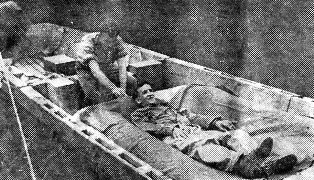 Cpl. Clarence E. Campbell of the Medical Corps prepares Collins for the last lap of the journey, floating down
the Gedu River.
Cpl. Clarence E. Campbell of the Medical Corps prepares Collins for the last lap of the journey, floating down
the Gedu River.
|
At the juncture of the Tarung and Gedu Rivers, the pontoon boats were made fast. Ulrich and Kulmatiski established a camp, kept the boats in readiness. The remainder of the party, led by a Naga guide, started the trek to the first bustee. The hike to the first settlement, a distance of four miles, took more than three hours.
On the following day the party covered an additional 15 miles over hazardous foot paths. That evening Gedu Ga, where Collins lay sick, was in sight on the next peak.
A Naga runner from the village was sent ahead with the message, and returned with the good news that the air rescue party had already made contact with Collins. (Throughout the days of effort to find, succor and save the pilot, the Naga hillmen helped at every hand, served tirelessly as messengers, bearers, scouts and liaison men, a tribute to the unknown, unsung men of the Army who walk the jungle trails alone and make friends of potential enemies.)
Meanwhile Lt. William F. Diebold, of the Air Reserve party, equipped with a walkie-talkie, had parachuted down to what was thought to be Gedu Ga. Discovering it was not the right bustee, he started over the trail to Collins' village.
Diebold found Collins weakened and emaciated. He suggested that medical personnel be dropped to the
 In the above picture Collins is shown being placed in an ambulance which will take him to a rear area hospital
for treatment of his wounds. Two unidentified medics lend a hand.
In the above picture Collins is shown being placed in an ambulance which will take him to a rear area hospital
for treatment of his wounds. Two unidentified medics lend a hand.
|
The land party returned to the assault barges as the three officers and Collins proceeded down the stream. Easing the bulky raft along, the Air-Rescue Group were forced to wade to prevent the boat from capsizing. Once in lowering it down a small falls, the ropes snapped and disaster threatened. Circling planes kept a constant vigil over the rescuers and provided liaison with the waiting land party.
A day and a half later contact was made with the land group at the juncture of the Tarung. Here Collins' boils were again dressed, leech infections treated and the sick flyer given a change of clothing.
The raft, with Collins aboard, was placed in an assault boat for the journey on the Tarung River. It was impossible to travel against the swiftly moving stream, so the combined parties started south in early afternoon and by dusk had traveled 60 miles to a point along the Ledo Road where an ambulance waited.
Collins had survived a 45 day ordeal in the wilds of Northern Burma, the first man to beat the death trap of the Gedu.
(FOOTNOTES: Spruell and Morrissey have had several previous bail-outs over the jungles to save the lives of downed airmen . . Diebold made his maiden leap only a few hours after reporting for duty with the rescue unit . . It was the first time that a rubber raft had been used for a Hump crash rescue by ICD . . Collins lost 55 of his normal 165 pounds during the trek through the jungle . . He went 22 days without seeing a human . . When the rubber raft was launched this first time, with Collins aboard, it broke away from an improvised shroud-like Hawser and was swept a mile downstream, out of control, before Morrissey could beach it . . To catch up with the raft, Spruell and Diebold had to inflate their Mae Wests and ride the rapids . . Diebold got caught in a whirlpool, bashed his head on a rock, and floated a mile, semi-conscious . . Of the raft trip, Collins said, "I'd rather bail out of a P-51 everyday in the week than make that trip again." . . During his lost 22 days, Collins lived on berries, bamboo shoots. he slept on rocks . . His greatest discomfort, aside from the lack of food, was the extreme cold at night.)
U.S. CASUALTY LISTS HIT 417,085 MARK
WASHINGTON - (ANS) - Latest War Department casualty figures, through Sept. 21, showed an increase of 16,325 since the report two weeks earlier, to bring total Army casualties to 351,293.
Totals for all services are now 417,085, including 68,658 Army dead and 25,963 Navy killed.
CBI Necktie Situation? Just Close Your Eyes
By S/Sgt. KARL PETERSON
Everybody check his barracks bag quick and make sure he still has his correct complement of neckties, cotton, khaki. Okay, good. You might need 'em any time - to hold your pants up, maybe.
The average American soldier in CBI has no more use for his issue neckties than he has for a quilted tea cosette. Considerations of tropical heat and other factors have moved our leaders mercifully to decree throughout most of the Theater uniform regulations calling for open collar.
NEAT TIE?
No G.I. with less than 20 years' service ever learns to tie a neat knot in the burlap khaki tie which Uncle gives us; the average effort has more wrinkles than an over-age prune. Yet we struggled valiantly in those happy peacetime days when the Army had more cravats than carbines. After elaborate weaving maneuvers with the arms before a mirror, you realized the end product was anything but the sought after double-dimple knot, whereupon you disassembled the whole thing and started over, provided you could get your arms unknotted.
Worst tie trouble we ever heard of back Stateside was at one Air Force station which we will not name, using instead the cryptic initials "J.B." where the C.O., interpreting uniform regulations that the tie will be inserted "between the first and second button of the shirt," called the collar button No. 1. On his post, neckties disappeared immediately below the knot as if the sheepish-faced members of the garrison had carelessly leaned over near a bacon-slicing machine.
Prior to March 1942, the sartorially-conscious selectee affected khaki tie by summer and black by winter, but at that time Army production veered from clothing to cannon and the black tie, hitherto correct for wear with the issue dinner jacket, was abandoned. (And don't any of you jokers who may have seen the recent news picture of Gen. Marshall in black tie start writing us letters - the Chief of Staff, like most other generals, makes his own uniform.)
THESE PARTS
Out in these hyar parts certain Armed Forces personnel who aspire to be clothes horses have from time to time donned neckties in areas where same are not required. This invariably provokes a violent reaction from their associates, who stare, then scowl, at the offender, then smirk and whisper to one another behind their hands. Such psychological pressure usually has the desired result of removing the obnoxious apparel.
Reason is, the lads are deathly afraid someone in high circles will spot the nattily togged out individual and decide to make neckties a must for local personnel. To avert such catastrophe, every G.I. rallies 'round to get it off him.
Actually, left to the reward of his own stupidity, the tie-wearer would soon discover that frequent dhobi'ing has greatly reduced the collar size of his shirt, until his tie feels like a jugular tourniquet. His face turns brick red like an Iroquois Indian with apoplexy, his eyes bug out, and he faces slow strangulation. All of which soon brings out the field soldier in him and the necktie is removed forthwith and relegated to strapping mosquito net poles on the legs of a bunk.

|
MYITKYINA - (UP) - Maj. Gen. Frank Merrill, leader of Burma's famed Merrill's Marauders unit, which, among other things, helped take Myitkyina air strip and began the campaign climaxing the fall of that city, is back in the China-Burma-India Theater on an undisclosed mission.
Wearing an extra star, which he acquired along with a badly needed rest in the United States, Merrill is making a flying trip to parts of the CBI. Returning in "Uncle Joe's Chariot," a C-47 cargo transport plane specially outfitted for Gen. Joseph W. Stilwell, Merrill's presence in the CBI may be an indication that imminent action may be expected in North Burma, where the Burma war has been confined to patrol activity recently.
During his ride in the Chariot, Merrill entertained accompanying officers and passengers with his accordion. He played old and new tunes, British ditties and Japanese infantry and cavalry songs.
14th AF Scourges Jap Columns
Roundup Staff Article
HQS., 14th AIR FORCE, CHINA - Japanese armies this week continued to drive on towards Kweilin despite fierce aerial pounding by the 14th Air Force, reaching a point 23 miles northeast of the city after capturing Paoching on the right flank.
Jap forces advancing from Wichow, evidently aiming to flank the Kwangsi capital to the south and strike at Liuchow, 95 miles southwest of Kweilin on the Hunan-Kwangsi Railroad, had taken Pingnam and the abandoned American airfield at Tanchuk.
Still other Nipponese troops landed in Fukien Province on China's southeast coast and prepared to seize vital Foochow, last seaport in Chinese hands.
Throughout the week, Maj. Gen. Claire Chennault's fighters and bombers roared over Jap troop concentrations along the Lingling highway and harried Jap shipping on the West River. Camouflaged troop-carrying barges were
|
Numerous Jap-held towns in the battle area were bombed by B-25's, which also struck by night at enemy airfields in the Canton area to hamper Nip air activity. On all missions, the raiders met interception only four times, once over far northwest of Kiukiang on the Yangtze, with seven Jap fighters shot down.
Several river steamers and many supply boats were sunk. Ten fuel barges went up in flames along the West River. Camouflage failing, the desperate enemy at one place used a "Q" boat, an apparently helpless target which suddenly bristles with guns as attacking planes come in low.
B-24's in the Formosa Straits sank one 3,100-ton Jap freighter, probably sank another, and damaged three large vessels. Gen. Joseph W. Stilwell reported the 14th's airmen had sunk 163,000 tons of enemy shipping in September, besides killing numerous Jap soldiers.
President Roosevelt also praised the performance of the 14th Air Force, in a Washington press conference wherein he answered complaints of inadequate American aid to China. The ATC's aerial supply of China had been epochal in the face of hardships, said the President, citing figures of 23,000 tons of freight flown over The Hump in one recent month. In one day ATC fliers made 569 sorties to haul 1,300 tons. FDR pointed out that Chiang Kai-shek had credited the ATC with keeping open a life-line to China.
Ledo, Burma Roads Junction Now In Sight, Says Stilwell
Roundup Staff Article
A juncture of the new Ledo Road with the old Burma Road, which will provide a much-needed ground supply route to China, is now in sight as a result of the successful American, British and Chinese offensives in the Salween and north Burma areas, Gen. Joseph W. Stilwell reported in a radio address to the U.S. this week.
(This broadcast was made from a record made by the CBI Radio Team here in this theater. It is part of a regular series "Yanks in the Orient," which is broadcast nationally throughout the U.S. by the 'Blue Network.')
While Stilwell was telling the nation of the objectives of the CBI Theater, Chinese troops on the Salween front strengthened their hold on recently occupied positions in the Lungling area - Tengchung, Pingka and other objectives. The Japs brought up artillery in their repeated attempts to drive the Chinese out of their positions, but the defenders held firm and inflicted many casualties on the attacking enemy.
The Chinese drive in this area is being aided considerably by Brig. Gen. Frank Dorn's Y-Forces.
LONELY UNCLE JOE TOO BUSY TO WRITE
YONKERS, N.Y. - (UP) - Two years ago when her teacher urged the class to write letters to lonely servicemen overseas, Joan Herald, 12, chose Gen. Joseph W. Stilwell.
She has just received an answer from the General, who apologized for being so tardy, explaining he had been rather busy. He said he appreciated the success of the Yonkers scrap metal drive, concluding, "With this letter come my very best wishes and hopes that you will never have to go through another war."
EAC Attacks Jap Railway
HQS., EAC - Two long-range attacks in one day by RAF Liberators on the vital Bangkok-Chiengmai railroad this week caused heavy damage to the line which supplies Jap forces in eastern and central Burma.
Flying a round-trip distance of over 2,000 miles, the bombers unloaded at low altitude and followed with strafing attacks. A loaded troop train was hit at Pitsunnuloke, 140 miles north of Bangkok, seven locomotives were destroyed or damaged, one small Bangkok bridge knocked out and the important Dara bridge damaged, and other damage done to stations and rail yards along the line.
B-25's hammered at enemy bridges in central Burma and on the Salween River front, knocking out three at Hsenwi after silencing anti-aircraft positions. Mangshih, Mawlu, Lashio and Pyinmana were also bombed.
Thunderbolt fighters supported British forces moving southwest from Myitkyina along the railroad corridor, and also ranged south as far as Lashio.
|
WAC RICKSHAW RACES
ENTERTAIN AAF G.I.'S
By way of livening up a dull summer afternoon, G.I.'s and WAC's at Maj. Gen. George E. Stratemeyer's AAF headquarters recently staged a rickshaw race, sponsored by Special Service, before a large crowd.
Winners were S/Sgt. Mary Higgins and Cpl. James Drummond, passenger and rickshaw-wallah respectively, who triumphed over Cpl. Christine Chadwick and Pvt. Noah Bass in the finals after these two teams had registered the fastest times in preliminary heats. The course was a 150-yard stretch along headquarters road.
WAC passengers were drawn for by lot, with no protests entertained by the rickshaw-pullers on the score of weight. CWO Paul Martin, Special Service Officer, had to do some fast last-minute talking to get the vehicles after the local rickshaw union had knocked off for a religious holiday.
Base commander, Lt. Col. Carl A. Junge presented a cup to the winners. Other competing teams consisted of Cpl. Virginia Hamilton and Cpl. Robert Richardson, Sgt. Bing Franklin and Sgt. Theodore Whitworth, Sgt. Jean Forrest and Pfc. John Boulis, and Pfc. Betty Shantz and Cpl. Charles Graninger.
DEACON LEADS HYMNS BEHIND GUNS OF B-29
B-29 SUPERFORTRESS BASE, WESTERN CHINA - (UP) - The most singular religious services of this war and Army, "The Deacon's Prayer Meetings," held in a Superfortress on Sunday flights over The Hump, have been conducted by a bombardier instead of a chaplain.
The congregation is the crew of the Superfortress and the leader of the services, known as "The Deacon," is Lt. Warren Dailey, bombardier and forward gunner. Most of the B-29's flights across The Hump have been on the Sabbath, and as the Superfortress has flown across, members of the crew have sung hymns, with the Deacon leading from his place in the nose of the plane.
When Dailey goes back home to Los Angeles and the life of an ordained Christian minister, he intends to use his experience as a Superfortress bombardier and gunner to create a broader, more tolerant, religion for the men of war who return for peace.
Dailey doesn't consider that he's killing human beings when he shoots down a Japanese plane or dumps his high explosives on Japanese industrial centers.
"I am only destroying the mechanisms of war," the leader of The Hump religious services said the other night, sitting in a tent at this base with several war correspondents. The only light in the tent came from a single, flickering candle which cast its dancing light across Dailey's intense face. He smiled.
"You see, I have to think that way," he said.
"Killing of men is a bad thing. War is a bad thing. But when we destroy the mechanisms of war, the machines that make war possible, we save American lives, we hurry the end of the war, and we're doing a good thing. That's the way I think about it."
One of the crew members of "the congregation" Superfortress is Dailey's brother-in-law, Lt. Tom C. Evans. They married twin sisters, Katy Lou and Betty Lee Kellison, daughters of the Rev. M. O. Kellison, pastor of the Wilshire Boulevard Christian Church of Los Angeles.
Evans, who is Dailey's best friend, married Betty Lee six months ago.
Dailey has been known as "Deacon" for about eight years. He picked up the name when he was attending high school at Ponca City, Okla., when he was helping out a local minister. Later he attended Oklahoma A. and M., taking a pre-ministerial course. Then the war caught him just as he was about the enter ministerial school.
The Deacon is going back to ministerial school when he gets home from the war. He wants to spread out to a larger congregation than he now has - his crew.
|
CHINA AIR BASE - Texas may have more perambulating beefsteaks and flowing gold, California more lemons and movie queens, and Brooklyn more Bum ball players and a tree growing in it, but Nevada has the most patriotism.
That's the way Cpl. Howard Gongwer, former student of Ohio State University, has it figured out.
"One of the greatest questions which has faced the Army since the war began is whether or not Texas has more men in the Army than any other State," Gongwer said here recently. "The War Department settled that question with its State breakdown of personnel statistics. Texas didn't win. Neither did California nor Brooklyn."
Then, points out Gongwer, the discussion took on a new trend. What State had the most men in the Army in proportion to its population? Texans were sure it was Texas; Californians knew it was California.
One night during an air raid alert, working part of the time in his company headquarters and the rest of the time in a cave with the aid of a flashlight, Gongwer settled the question for good and all. Using the War Department's personnel figures by State and the State population figures (1940 census) as published in The World Almanac, Gongwer revealed that Nevada, with a population of a little more than 110,000, has more than 8 percent of its population in the Army. No other State had 8 percent, the District of Columbia being second with 7.98 percent.
|
|
Thirteenth Jump No Jinx - Yet
HQ., TENTH AIR FORCE IN INDIA - Is the 13th parachute jump unlucky? Former paratrooper and now a fighter-bomber pilot with the Red Gorillas squadron, 10th Air Force, Eastern Air Command, Lt. Norbert J. Murray, made a dozen jumps as a paratrooper. Following the 12th jump he transferred to aviation cadet training and became a pilot. Recently, when he took off on a routine flight, his aircraft gave him trouble and he had a decision forced upon him: to make or not to make the 13th jump. He took the supposedly unlucky leap, landing safely within a few miles of his base but in heavy jungle. With compass and machete, he beat his way to a road where he found a jeep parked by a searching party. He concluded the 13th jump by seeking out the search party and bringing it back to "safety." |
Japs Dug Deep At Myitkyina
MYITKYINA - The Japs were really dug in at Myitkyina. Take it from Col. William S. Pocock, commanding an Air Service Command unit in this area. Three of his officers recently captured Jap soldiers in the area.
Lt. Charles S. Samples, assistant ordnance officer with the group, was out in the jungle grass searching for some equipment when he heard a rustling in the weeds. He uncovered an emaciated but still dangerous Jap, and at pistol point led him to the Combat Headquarters for handling.
Lt. Jack M. Gober, and Chief Warrant Officer Herbert W. Carr, were surveying a possible site for engineering operations when they noticed an undersized soldier coming toward them. He stopped and turned. Gober, an MP officer with the ASC outfit, called, "Halt," but the stranger bolted and ran. The two officers shot at him as he disappeared into the jungle and then pursued him for several hundred yards.
The Jap knew his camouflage, so the men returned, secured a contingent of Gurkha bearers and closed in on the quarry. Captured, the Jap was taken to Combat Headquarters.
Pocock's outfit, under Theater command of Maj. Gen. Thomas J. Hanley, has been holding down the Myitkyina situation, maintenance and aircraft supply-wise for quite some time. Then men are keeping all airplanes in the air at Myitkyina and going far afield to salvage crashed ships. They also provide the bombs, air ordnance, and gasoline for the tactical air squadrons of Burma.
Elephant Transgresses AR
HQS., TENTH AIR FORCE, INDIA - The CO of a fighter group here had his desk graced on a recent morning by the following correspondence from one of his squadron commanders in Burma:
1. Contary to instructions no doubt contained in some AR or Memorandum (numbered or unnumbered), Hqs., Tenth Air Force or otherwise, this squadron's camp was invaded, transgressed and damaged by one each wild Burma elephant at 0200 hours.
2. At the first sight of the mud-borne pachyderm invasion, the Airdrome Defense Plan went into operation. Combat teams were quickly formed and detailed, some armed with tommy guns, other with carbines, others flashlights, some men in shorts, others in nothing at all. Those with nothing at all were detailed to run back and forth and holler. Those with flashlights searched the trees and vines for any airborne ape attacks in case a combined operation was in progress.
3. Needless to say, this stellar squadron (first in war, first in Burma, first in Myitkyina and just naturally first) repelled the invasion with no casualties and with damage limited to four tents, one each one-ton trailer and a slightly used latrine.
4. It is requested that Group Hqs. issue an order prohibiting events of this nature and, if necessary, confining the offender to an area east of the river.
5. It's a rough war (signed) Robert J. Becker, Major, Air Corps., Commanding.
SERGEANT EXPLAINS HOW TO GET PROMOTED IN ARMY
By T/7 OSMOSIS FINK Roundup Roving Reporter
CHINA AIR BASE - If each G.I. in the Army were like S/Sgt. Merlin G. Jones, more corporals would be sergeants in less time.
Jones, when he got advanced from corporal to sergeant, probably received a promotion under stranger circumstances than any non-com.
"When I was a recruit," said Jones here recently, "they told me that advancement depended on me. I took them literally."
At the time Jones first got a new captain as officer-in-charge of the section in which he was chief clerk, he was a corporal; but the captain on every occasion addressed him as "sergeant." It went on for months with Jones the possessor of only two stripes.
"I'm not a sergeant, sir. I'm a corporal!" Jones would protest.
All this happened in the U.S.A. before Jones' outfit came to CBI-land. Weeks passed into months with the captain still calling him a sergeant. On many occasions Jones would call it to the captain's attention that he was still a corporal.
Finally, one afternoon when the captain was away looking after the unloading of some supplies, Jones worked away industriously at a piece of military correspondence for the captain's signature. being a good soldier, he wanted it to look right, so he did it over three times before he was satisfied.
It was the captain's habit, if he had been forced to absent himself from his office for any length of time during the day, to come by just before recall to see if there was anything which needed his attention. Accordingly, just before quitting time he bounded in, wanting to know what had transpired while he was away.
There was one letter to be signed.
The captain was always in a hurry, so he grabbed the letter, signed it, reached the door on the way out and stopped.
"By the way, Sgt. Jones, what was that I just signed?" questioned the captain.
"That was a recommendation for my promotion, sir," said Cpl. Jones.
"A damned fine idea!" exulted the captain, "Been meaning to do that for a long time!"
The group commander approved it, but strange to relate, the captain, who would be known in Flatbush as a character, called the sergeant a corporal from that day forward.
The C.B.I. Roundup is a weekly newspaper of the United States Forces, published by and for the men in China, Burma, and India, from news and pictures supplied by staff members, soldier correspondents, United Press, OWI, and Army News Service. The Roundup is published Thursday of each week and is printed by The Statesman in New Delhi and Calcutta, India. Editorial matter should be sent directly to Capt. Floyd Walter, Hq., U.S.F., I.B.T., New Delhi, India, and should arrive not later than Sunday in order to make that week's issue. Pictures must arrive by Saturday and must be negatives or enlargements. Stories should contain full name and organization of sender. Complaints about circulation should be sent directly to Lt. Boyd Sinclair, Hq., U.S.F., I.B.T., New Delhi, India. Units on the mailing list should make notification of any major change in personnel strength or any change of APO.

OCTOBER 12, 1944
Adapted from the original issue of C.B.I. Roundup
Copyright © 2007 Carl Warren Weidenburner
TOP OF PAGE PRINT THIS PAGE ABOUT THIS PAGE SEND COMMENTS
PREVIOUS ISSUE CLOSE THIS WINDOW NEXT ISSUE
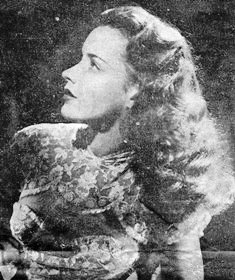

 American Army Nurses in southwestern China take time off from their duties at an SOS Station Hospital for
relaxation. In the picture on the left, Lts. Lillian G. Kelley, Lakeworth, Fla., (left) and Ruth E. Allair,
Oakland, Calif., aare shown "taking the grain to market." (Buffalo and friend unnamed.) Shown in the right photo
are Lts. Kelley, Ruth A. Frost, Visalia, Calif., and Allair planning a sampan ride up the canal to visit the
"Temple of the Western Hills."
American Army Nurses in southwestern China take time off from their duties at an SOS Station Hospital for
relaxation. In the picture on the left, Lts. Lillian G. Kelley, Lakeworth, Fla., (left) and Ruth E. Allair,
Oakland, Calif., aare shown "taking the grain to market." (Buffalo and friend unnamed.) Shown in the right photo
are Lts. Kelley, Ruth A. Frost, Visalia, Calif., and Allair planning a sampan ride up the canal to visit the
"Temple of the Western Hills."
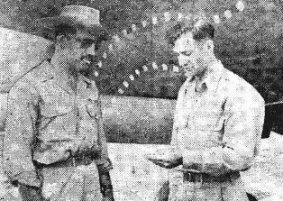 Lockheed Aircraft Co. is quite proud of the way in which pilots of the Twin Dragon Squadron have used their
P-38's against the Jap in Burma. And so Tech. Rep. Wayne O. Sneedon (right) presented the entire squadron with
Lockheed pins - gold miniatures of a P-38. Here Squadron CO Maj. Verl D. Luehring receives his pin from Sneedon.
Lockheed Aircraft Co. is quite proud of the way in which pilots of the Twin Dragon Squadron have used their
P-38's against the Jap in Burma. And so Tech. Rep. Wayne O. Sneedon (right) presented the entire squadron with
Lockheed pins - gold miniatures of a P-38. Here Squadron CO Maj. Verl D. Luehring receives his pin from Sneedon.
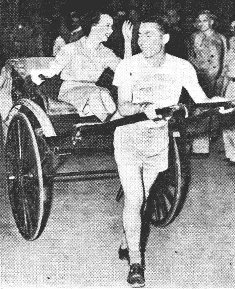 The belle in the 'shaw is Cpl. Virginia Hamilton and the well-barbered gent with the teeth is Cpl. Robert
Richardson. The Hamilton-Richardson team finished up the track in the Hooghly Handicap but look at the laughs they
get.
The belle in the 'shaw is Cpl. Virginia Hamilton and the well-barbered gent with the teeth is Cpl. Robert
Richardson. The Hamilton-Richardson team finished up the track in the Hooghly Handicap but look at the laughs they
get.
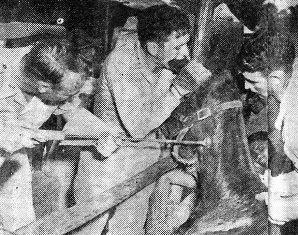 Even a G.I. mule must have his "dog tags." And up at APO 628 it's the job of Lt. Carl W. Schultz, of the Army Vet.
Corps. to apply the branding iron. Here he's being aided by Sgt. Fred parker (with a mouthful of ear) and Sgt. R. Sterling
Crawford.
Even a G.I. mule must have his "dog tags." And up at APO 628 it's the job of Lt. Carl W. Schultz, of the Army Vet.
Corps. to apply the branding iron. Here he's being aided by Sgt. Fred parker (with a mouthful of ear) and Sgt. R. Sterling
Crawford.